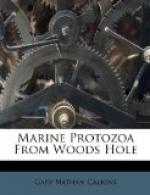KEY TO THE MARINE GENERA OF TINTINNIDAE.
Diagnostic characters: Body attached by a stalk to a cup. Inside the zone of membranelles is a ring of cilia (par-oral).
1. The test is gelatinous and more or Genus
Tintinnidium
less covered by foreign particles
2. The test is chitinous and clear.
Genus Tintinnus
No foreign particles.
3. The test is chitinous; covered by Genus
*_Tintinnopsis_
foreign particles, growth rings
frequent
4. The test is chitinous, often Genus
Codonella
covered by foreign particles.
The test is marked by discoid,
circular, or hexagonal spots.
5. The test is perforated by pores Genus
Dictyocysta
of circular or hexagonal form.
* Presence at Woods Hole indicated by asterisk.
Genus TINTINNOPSIS Stein ’67.
(Stein ’67; Kent ’81; Daday ’87; Buetschli ’88.)
Medium-sized ciliates, inclosed in a chitinous lorica with embedded sand crystals. The form of the house, or lorica, varies greatly. In some cases the mouth opening is wide, giving the lorica a bell form; it may be long and tubular, short and spherical, or variously indented. The animal is attached, as in the closely allied genus Tintinnus, by a peduncle to the bottom of the lorica. The anterior end of the animal is inclosed by two complete circles of cilia; one, the outer, forming the adoral zone, is composed of thick tentacle-like membranelles, the other consists of shorter cilia within the adoral zone. The mouth leads into a curved oesophagus containing rows of downward-directed cilia (Daday). The entire body is covered with cilia, but as the lorica is always opaque these can be made out only when the animal is induced to leave the house. The only difference between this genus and Tintinnus is the covering of foreign bodies—usually sand crystals. Movement is rapid and restless, and peculiarly vibratory, owing to the apparent awkwardness in moving the house. Salt water.
Tintinnopsis beroidea Stein, var. plagiostoma Daday. Fig. 47.
Synonym: Codonella beroidea Entz ’84.
The shell is colorless, thimble-shaped, with a broadly rounded posterior end. The body is cylindrical. The internal organs were not observed. Membranelles 24 in number. Length 50 mu; greatest diameter 40 mu.
[Illustration: Fig. 47.—Tintinnopsis beroidea.]
Var. compressa Daday ’87.
The posterior end of the shell is pointed, the lower third of the shell is swollen, the upper third is uniform in diameter and without oral inflation or depression. Nucleus not seen.
Length 70 mu; greatest diameter 48 mu.
Tintinnopsis davidoffi Daday. Fig. 48.
The shell is large, elongated, and provided with a considerable spine. The chitin of the shell is covered with silicious particles of diverse size. The internal structures were not observed.




